Timișoara
Timișoara (UK: /ˌtɪmiˈʃwɑːrə/, US: /ˌtiːm-/,[6][7] Romanian: [timiˈʃo̯ara] (![]()
![]()
Timișoara | |
|---|---|
City and County Seat | |
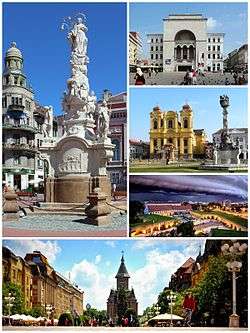 | |
| Nickname(s): | |
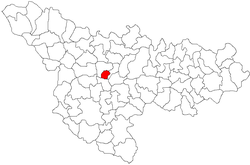 Location in Timiș County | |
 Timișoara Location of Timișoara within Romania | |
| Coordinates: 45°45′35″N 21°13′48″E | |
| Country | |
| County | |
| Status | County capital |
| First official record | 1212 (as Temesiense) |
| Government | |
| • Mayor | Nicolae Robu[2] (PNL) |
| • Deputy Mayor | Dan Diaconu (PNL) |
| • Deputy Mayor | Imre Farkas (UDMR) |
| Area | |
| • City and County Seat | 130.5 km2 (50.4 sq mi) |
| • Metro | 2.439,19 km2 (0.94178 sq mi) |
| Elevation | 90 m (300 ft) |
| Population (2011 census)[3] | |
| • City and County Seat | 319,279 |
| • Estimate (2016)[4] | 332,983 |
| • Rank | 3rd (98th in EU) |
| • Density | 2,447/km2 (6,340/sq mi) |
| • Metro | 468,162 |
| Demonym(s) | timișorean (masculine), timișoreancă (feminine) |
| Time zone | UTC+2 (EET) |
| • Summer (DST) | UTC+3 (EEST) |
| Postal code | 300001-300990 |
| Tel. code | 0256 / 0356 |
| Car Plates | TM |
| Climate | Cfb |
| Website | www |
| xTimișoara metropolitan area is a proposed project. | |
Nicknamed the Little Vienna or the City of Flowers, Timișoara is considered the informal capital city of the historical Banat. The country's third most populous city is the economic hub of the region, with 319,279 inhabitants as of the 2011 census,[3] home to almost a half-million inhabitants in the metropolitan area, as well as ca. 50,000 students[8] from over 50 countries.[9]
In late contemporary times, Timișoara, like many other large cities in Romania, is a medical tourism service provider especially for dental care.[10][11] It also offers excellent academic institutions, attracting thousands international students annually mainly at its medical school.[9] As a technology hub, the city has one of the most powerful IT sectors in Romania alongside Bucharest, Cluj-Napoca, Iași, and Brașov,[12] becoming a popular tech destination according to Financial Times.[13] In 2013 Timișoara had the fastest internet download speed in the world.[14] Along with Oradea, Timișoara is part of the Art Nouveau European Route.[15]
It was the first city in the Habsburg Monarchy with street lighting (1760) and the first European city to be lit by electric street lamps in 1884.[16] It opened the first public lending library with reading room in the Habsburg Empire and built a municipal hospital 24 years before Vienna.[16] Also, it published the first German newspaper in Southeast Europe (Temeswarer Nachrichten).[16] It has been an important centre for music in Europe since the 19th century.[16] The Romanian Revolution began in Timișoara.[17]
The city will be the next European Capital of Culture in 2021.[18]
Etymology
The Hungarian name of the town, Temesvár, was first recorded as Temeswar in 1315.[19] It refers to a castle (vár) on the River Timiș (Temes).[19] The Romanian and German names (Timișoara and Temeschwar, respectively) derived from the Hungarian form.[19] Other names in different languages: in Yiddish: טעמשוואר, romanized: Temshvar, in Serbian: Темишвар, romanized: Temišvar, in Banat Bulgarian: Timišvár and in Slovak: Temešvár. The name of the city originates from the river which passes the city, Bega, initially known as Little Timiș (Hungarian: Kistemes, Romanian: Micul Timiș).[20][21]
History
Early history
The first identifiable civilization in Banat region were the Dacians who left traces of their past.[22] Nearby archaeological finds indicate settlements of Neolithic[23][24] and Roman origins.[24] From coin finds, it is known that the area was inhabited during Roman Dacia.[24]
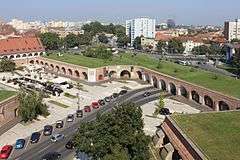
Middle Ages
Timișoara was first officially mentioned as a place in 1212 as the Roman castrum Temesiensis[24] or Castrum regium Themes.[25] The town was destroyed by the Tatars in the 13th century but Timișoara was rebuilt and grew considerably during the reign of Charles I of Hungary, who, upon his visit there in 1307, ordered the fortress to be fortified with stone walls and to build a royal palace. Italian craftsmen and architects were used.[26][27] He even moved the royal seat from Buda to Temesvár between 1315 and 1323.[27] Timișoara's importance also grew due to its strategic location, which facilitated control over the Banat plain.[27] By the middle of the 14th century, Timișoara was at the forefront of Western Christendom's battle against the Muslim Ottoman Turks. Crusaders met at the city before engaging in the Battle of Nicopolis in 1396. Beginning in 1443, John Hunyadi used Timișoara as a military stronghold against the Turks,[27] having built a powerful fortress. The land of Banat was attacked by the Ottomans in 1462 and 1476, and the city was repeatedly besieged by them in 1491 and finally in 1522.[27]
16th–19th centuries
In 1552, a 16,000-strong Ottoman army led by Kara Ahmed Pasha conquered the city and transformed it into a capital city in the region (Temeşvar Eyalet). The local military commander, István Losonczy, and other Christians were massacred on 27 July 1552 while escaping the city through the Azapilor Gate.[28]
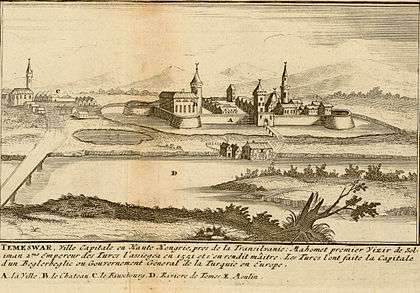
Timișoara remained under Ottoman rule for nearly 160 years, controlled directly by the Sultan and enjoying a special status, similar to other cities in the region such as Budapest and Belgrade. During this period, Timișoara was home to a large Islamic community and produced famous historical figures such as Osman Aga of Temesvar, until Prince Eugene of Savoy conquered it in 1716 during the Ottoman-Habsburg war. Subsequently, the city came under Habsburg rule and was colonized with Swabian Germans, and it remained so until the early 20th century,[24] as part of the Banat of Temeswar, Kingdom of Hungary, Austrian Empire and Austria-Hungary, except for the Ottoman occupation between 1788 and 1789 during the 1787–91 Austro-Turkish War.
The city was under siege in 1848 for 107 days. The Hungarians unsuccessfully tried to capture the fortress in the Battle of Temesvár. It was the last major battle in the Hungarian Revolution of 1848.[24]
The fortifications were removed starting in 1892 up until 1910, and several major road arteries were built to connect the suburbs with the city centre, paving the way for further expansion of the city.[29]
Timișoara has been an important economic centre since the 18th century when the Habsburg administration was installed. Due to Austrian colonisation, ethnic and religious diversity and innovative laws, the economy began to develop. The technicians and craftsmen that settled in the city established guilds and helped develop the city's economy. In 1717, Timișoara became host to the first beer factory in Banat.[30]
During the Industrial Revolution, numerous modern innovations were introduced. The Bega river was also channelled during this time. It was the first city with horse-drawn trams (1869) and the first navigable canal on current Romanian territory.[16] This way, Timișoara had contact with Europe, and even with the rest of the world through the Black Sea, leading to the local development of commercialism.[31][32][33] In the 19th century, the railway system of the Hungarian Kingdom reached Timișoara. It was the first city in the Habsburg Monarchy with street lighting, and the first city in Europe and second in the world after New York illuminated by electric light.[34][35]
20th century
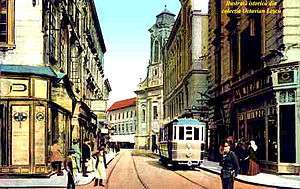
On 31 October 1918, local military and political elites established the "Banat National Council", together with representatives of the region's main ethnic groups: Germans, Hungarians, Serbs, and Romanians. On 1 November they proclaimed the short-lived Banat Republic. In the aftermath of World War I, the Banat region was divided between the Kingdom of Romania and the Kingdom of Serbs, Croats and Slovenes, and Timișoara came under Romanian administration after Serbian occupation between 1918 and 1919. The city was ceded from Hungary to Romania by the Treaty of Trianon on 4 June 1920. In 1920, King Ferdinand I awarded Timișoara the status of a University Centre, and the interwar years saw continuous economic and cultural development. A number of anti-fascist and anti-revisionist demonstrations also took place during this time.
During World War II, Timișoara suffered damage from both Allied and Axis bombing raids, especially during the second half of 1944. On 23 August 1944, Romania, which until then was a member of the Axis, declared war on Nazi Germany and joined the Allies. The German and Hungarian troops attempted to take the city by force throughout September, but without success.
After the war, the People's Republic of Romania was proclaimed, and Timișoara underwent Sovietization and later, Systematization. The city's population tripled between 1948 and 1992. Timișoara became highly industrialised both through new investments and by increasing the capacities of the old enterprises in various industries: machine building, textile and footwear, electrical, food, plastics, optical, building materials, furniture.[36][37]
In December 1989, Timișoara witnessed a series of mass street protests in what was to become the Romanian Anti-Communist Revolution.[38] On 20 December, three days after bloodshed began there, Timișoara was declared the first city free of Communism in Romania.[39]
Geography
Timișoara lies at an altitude of 90 metres (300 feet) on the southeast edge of the Banat plain, part of the Pannonian Plain near the divergence of the Timiș and Bega rivers. The waters of the two rivers form a swampy and frequently flooded land. Timișoara developed on one of few places where the swamps could be crossed. These constituted a natural protection around the fortress for a very long time, however, they also favoured a wet and insalubrious climate, as well as the proliferation of the plague and cholera, which kept the number of inhabitants at a relatively low number and significantly prevented the development of the city. With time, however, the rivers of the area were drained, dammed and diverted. Due to these hydrographical projects undertaken in the 18th century, the city no longer lies on the river Timiș, but on the Bega Canal. This improvement of the land was made irreversible by building the Bega Canal (started in 1728) and by the complete draining of the surrounding marshes. However, the land across the city lies above a water table at a depth of only 0.5 to 5 metres (1.6–16.4 feet), a factor which does not allow the construction of tall buildings. The rich black soil and relatively high water table make this a fertile agricultural region.
Climate
Climate in this area has mild differences between highs and lows, and there is adequate rainfall year-round. The Köppen Climate Classification subtype for this climate is "Cfb" (oceanic climate).[40]
The climate which defines Timișoara city is the oceanic climate (Köppen: Cfb) and can be regarded as humid continental (Dfb) when using an isotherm of 0 °C (32 °F). The city characterises the South-Eastern part of The Pannonian Basin.
| Climate data for Timișoara, Romania (1961–1990) | |||||||||||||
|---|---|---|---|---|---|---|---|---|---|---|---|---|---|
| Month | Jan | Feb | Mar | Apr | May | Jun | Jul | Aug | Sep | Oct | Nov | Dec | Year |
| Record high °C (°F) | 17.4 (63.3) |
20.5 (68.9) |
28.2 (82.8) |
32.0 (89.6) |
34.5 (94.1) |
38.4 (101.1) |
41.1 (106.0) |
41.0 (105.8) |
39.7 (103.5) |
33.8 (92.8) |
27.1 (80.8) |
20.2 (68.4) |
41.1 (106.0) |
| Average high °C (°F) | 2.3 (36.1) |
5.6 (42.1) |
11.9 (53.4) |
17.6 (63.7) |
22.8 (73.0) |
25.7 (78.3) |
27.8 (82.0) |
27.6 (81.7) |
24.0 (75.2) |
18.1 (64.6) |
10.3 (50.5) |
4.2 (39.6) |
16.5 (61.7) |
| Daily mean °C (°F) | −1.6 (29.1) |
1.2 (34.2) |
5.8 (42.4) |
11.2 (52.2) |
16.3 (61.3) |
19.4 (66.9) |
21.1 (70.0) |
20.4 (68.7) |
16.5 (61.7) |
11.0 (51.8) |
5.6 (42.1) |
0.8 (33.4) |
10.6 (51.1) |
| Average low °C (°F) | −4.8 (23.4) |
−2.3 (27.9) |
1.2 (34.2) |
5.8 (42.4) |
10.1 (50.2) |
13.4 (56.1) |
14.6 (58.3) |
14.3 (57.7) |
11.2 (52.2) |
6.2 (43.2) |
2.1 (35.8) |
−1.7 (28.9) |
5.8 (42.4) |
| Record low °C (°F) | −35.3 (−31.5) |
−29.2 (−20.6) |
−20.0 (−4.0) |
−5.2 (22.6) |
−5.0 (23.0) |
2.2 (36.0) |
5.9 (42.6) |
5.0 (41.0) |
−1.9 (28.6) |
−6.8 (19.8) |
−15.4 (4.3) |
−24.8 (−12.6) |
−35.3 (−31.5) |
| Average precipitation mm (inches) | 40 (1.6) |
36 (1.4) |
37 (1.5) |
48 (1.9) |
65 (2.6) |
76 (3.0) |
64 (2.5) |
50 (2.0) |
40 (1.6) |
39 (1.5) |
48 (1.9) |
50 (2.0) |
593 (23.3) |
| Average snowfall cm (inches) | 9.8 (3.9) |
9.3 (3.7) |
4.4 (1.7) |
0.0 (0.0) |
0.0 (0.0) |
0.0 (0.0) |
0.0 (0.0) |
0.0 (0.0) |
0.0 (0.0) |
0.0 (0.0) |
3.7 (1.5) |
7.2 (2.8) |
34.4 (13.6) |
| Average precipitation days (≥ 1.0 mm) | 7 | 7 | 7 | 8 | 9 | 10 | 7 | 6 | 6 | 5 | 8 | 9 | 89 |
| Average relative humidity (%) | 90 | 86 | 79 | 73 | 73 | 74 | 73 | 75 | 76 | 81 | 85 | 89 | 79 |
| Mean monthly sunshine hours | 72.1 | 92.2 | 155.4 | 186.4 | 242.4 | 262.3 | 300.6 | 280.2 | 217.5 | 177.3 | 86.4 | 56.9 | 2,129.7 |
| Source 1: NOAA,[41] Deutscher Wetterdienst[42] | |||||||||||||
| Source 2: Romanian National Statistic Institute (extremes 1901–2000)[43] | |||||||||||||
- Highest recorded temperature: 42 °C (108 °F) – 5 August 2017
- Lowest recorded temperature: −35.3 °C (−32 °F) – 24 January 1963
- Snow stays on the ground 30 days a year on average
- Highest precipitation: June: 91.0 mm(3.589 in)
- Lowest precipitation: February: 44.5 mm(1.737 in)
Climatic general features consist of various and irregular weather conditions. The dominating temperate air masses during spring and summer are of oceanic origin and come with great precipitations. Frequently, even during winter period, the Atlantic humid air masses bring rainy and snowy weather, rarely cold weather.
From September until February, frequent continental polar air masses coming from the East invade the area. In spite of all that, the Banat climate is also influenced by the presence of cyclones and warm air masses which come from the Mediterranean. Their characteristic feature is that of complete snow thaw during the winter period and stifling heat during the summer period.
Freak measurable snowfalls have occurred as early as late October and as late as early April, but snow in those months is rare, and significant falls do not usually occur until first of November. The median date for the first freeze is 22 October, while that of the last freeze is 15 April.
Demographics
| Year | Pop. | ±% |
|---|---|---|
| 1787 | 9,479 | — |
| 1847 | 18,103 | +91.0% |
| 1869 | 32,725 | +80.8% |
| 1880 | 33,694 | +3.0% |
| 1890 | 39,884 | +18.4% |
| 1900 | 53,033 | +33.0% |
| 1910 | 72,555 | +36.8% |
| 1920 | 82,689 | +14.0% |
| 1930 | 91,580 | +10.8% |
| 1941 | 110,840 | +21.0% |
| 1948 | 111,987 | +1.0% |
| 1956 | 142,257 | +27.0% |
| 1966 | 174,243 | +22.5% |
| 1977 | 269,353 | +54.6% |
| 1992 | 334,115 | +24.0% |
| 2002 | 317,660 | −4.9% |
| 2011 | 319,279 | +0.5% |
| 2016 | 332,983 | +4.3% |
| Source: Census data, Encyclopædia Britannica Eleventh Edition | ||
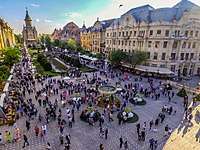
As of 2011 census data, Timișoara has a population of 319,279.[3] As defined by INS, the Timișoara functional urban area has a population of 468,162.[5]
Of this population, 86.79% were ethnic Romanians, while 5.12% were Hungarians, 1.37% Germans, 1.3% Serbs, 0.69% Romani, 0.18% Ukrainians, 0.17% Slovaks, 0.11% Jews and 0.76% others.[44] 14.2% of the population are under 15 years of age, 4.0% are over 75.
Since 1990, Timișoara saw a slight population decline owing to migration and a drop in birthrates. Notably, the Hungarian and German communities experienced significant decline, with the latter being reduced by half between 1992 and 2002.[45] On the other hand, the Ukrainian community has grown, partly due to the presence of Ukrainian language educational facilities. In recent years, local investment by Italian companies has spurred the creation of an Italian community,[46] even leading to calls for an Italian Cultural Center.[47]
Economy
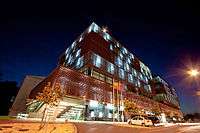
The economy of Timișoara has historic tradition in manufacturing, commerce, transport, education, communications and tourism.
After the fall of communism and the transition to a market economy, the private sector grew steadily. In the first decade of the 21st century, Timișoara has experienced an economic boom as the amount of foreign investment, especially in high-tech sectors, has risen. In an article in late 2005, French magazine L'Expansion called Timișoara Romania's economic showcase, and referred to the increased number of foreign investments as a "second revolution". In 2016, Timișoara was awarded by Forbes as the most dynamic city and the best city for business in Romania.[49]
Apart from domestic local investment, there has been significant foreign investment from the European Union, particularly from Germany and Italy. Continental AG has produced tires since opening a plant in 1998.[50] In the years that followed, Continental also established an automotive software engineering division in Timișoara. All in all, as of 2015 Continental AG employed about 8000 people in Timișoara, and the company keeps expanding.[51] The Linde Group produces technical gases, and a part of the wiring moulds for BMW and Audi vehicles are produced by the company Dräxlmaier Group. Wiring for Volkswagen and other vehicles are produced at the German company Kromberg & Schubert. Also, Swiss company FM Logistic, already present in Timiș County for Alcatel-Lucent, Nestlé, P&G, Smithfield and in Bucharest for Cora, L'Oréal, Sanofi Aventis and Yves Rocher, and for companies like PROFI Rom Foods, BIC, Kraft Foods or SCA Packaging—offering them domestic transport services and international transport services for Bricostore, Arctic, Danone, Unilever or Contitech, the growth of FM Logistic in Romania and in Dudești through its first warehouse in Romania (Dudeștii Noi gives FM the opportunity). Nestlé produces waffles here. The USA company Flextronics maintains a workplace in the west of the city for the production of mobile telephony and government inspection department devices.[52] The American company Procter & Gamble manufactures washing and cleaning agents in Timișoara. Smithfield Foods—the world's largest pork processor and hog producer—has two subsidiaries in Timișoara and Timiș County: Smithfield Ferme and Smithfield Prod.
The city has two large shopping malls: Iulius Town Timișoara and Shopping City Timișoara.
Transport
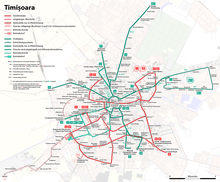
Timișoara is crossed by a major Trans-European Transport Network route: Pan-European transport corridor IV (road&railway).
The city has a complex system of regional transportation, providing road, air and rail connections to major cities in Romania and Europe.
Public transportation
Timișoara's public transport network consists of 7 tram lines, 8 trolleybus lines and 23 bus lines and it is operated by STPT (Societatea de Transport Public Timișoara), a company owned by the City Hall. The system covers all the important areas of the city and it also connects Timișoara with some of the communes of the metropolitan area.
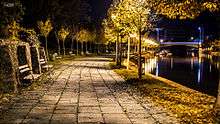
In 2015, Timișoara became the first city in Romania to offer public transport by bike. The bicycle-sharing system has 25 stations and 300 bikes which can be used by locals and tourists for free.[53] Starting from 4 October 2018, STPT also offers vaporetto public transport on the Bega canal, resulting in Timișoara being the only city in Romania with 5 types of public transportation.[54][55]
Road
Timișoara is on two European routes (E70 and E671) in the European road network. At a national level, Timișoara is located on four different national roads: DN6, DN69, DN59 and DN59A. The Romanian Motorway A1 links the city with Bucharest and the eastern part of the country. The A1 links Timișoara with Hungarian motorway M43. The Timișoara Coach Station (Autogara) is used by several private transport companies to provide coach connections from Timișoara to a large number of locations from all over the country.[56]
Air
The city is served by Romania's third busiest airport, Traian Vuia International Airport, located 12.3 km (7.6 mi) northeast away from the city centre. It serves now as an operating base for TAROM, and low-cost airlines such as Wizz Air and Ryanair.
The city's first airport, the Cioca Aerodrome, had remained in use for recreational and utility aviation, but was under threat of closure in 2016–2017.[57]
Railway
Timișoara is a major railway centre and is connected to all other major Romanian cities, as well as local destinations, through the national CFR network. Timișoara is directly linked by train service with Budapest, Belgrade and Vienna. The main railway station of the city is Timișoara North railway station. More than 130 trains use this station daily. The other three railway stations of the city are mainly used by commuter trains.
Cityscape
Completed high-rise buildings
- Fructus Plaza
- Real Estate Centre ASIROM-VIG
- AGN Business Center
- Vox Technology Park
- Iulius Town UBC 1
- Iulius Town UBC 2
- Iulius Town UBC 3
In progress
- Iulius Town UBC 0 155 metres (509 feet)
- ISHO Riverside A
- ISHO Parkside D
- Bega Business Center
Government
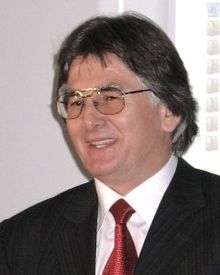
The first free local elections in post-communist Timișoara took place in 1992. The winner was Viorel Oancea, of the Civic Alliance Party (PAC), which later merged with the Liberal Party. He was the first officer who spoke to the crowd of revolutionaries gathered in Opera Square. The 1996 elections were won by Gheorghe Ciuhandu, of the Christian Democrats. He had four terms, also winning elections in 2000, 2004 and 2008. Meanwhile, Ciuhandu took over the Christian Democratic Party and ran for president of Romania in 2004. Timișoara's mayor, elected in 2012 and again in 2016, is Nicolae Robu. Deputy mayors are Dan Diaconu (PNL) and Farkas Imre (UDMR).
Like all other local councils in Romania, the Timișoara local council, the county council and the city's mayor are elected every four years by the population. Decisions are approved and discussed by the local council made up of 27 elected councillors.[58] Local council composition after 2016 local elections:[59]
| Party | Seats | Current Council | ||||||||||||
|---|---|---|---|---|---|---|---|---|---|---|---|---|---|---|
| National Liberal Party (PNL) | 12 | |||||||||||||
| Social Democratic Party (PSD) | 9 | |||||||||||||
| People's Movement Party (PMP) | 2 | |||||||||||||
| Democratic Alliance of Hungarians in Romania (UDMR/RMDSZ) | 2 | |||||||||||||
| Alliance of Liberals and Democrats (ALDE) | 1 | |||||||||||||
| Adrian Orza (independent) | 1 | |||||||||||||
Additionally, as Timișoara is the capital of Timiș County, the city hosts the palace of the prefecture, the headquarters of the county council (consiliu județean) and the prefect, who is appointed by Romania's central government. The prefect is not allowed to be a member of a political party, and his role is to represent the national government at the local level, acting as a liaison and facilitating the implementation of National Development Plans and governing programmes at the local level. County council composition after 2016 local elections:[60]
| Party | Seats | Current Council | ||||||||||||||||
|---|---|---|---|---|---|---|---|---|---|---|---|---|---|---|---|---|---|---|
| Social Democratic Party (PSD) | 16 | |||||||||||||||||
| National Liberal Party (PNL) | 14 | |||||||||||||||||
| People's Movement Party (PMP) | 5 | |||||||||||||||||
| Alliance of Liberals and Democrats (ALDE) | 2 | |||||||||||||||||
Currently, the city is the largest in the West development region, which is equivalent to NUTS-II regions in the European Union and is used by the European Union and the Romanian Government for statistical analysis and regional development. The West development region is not, however, an administrative entity.[58]
Districts
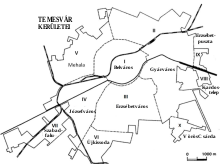
Timișoara city traditionally divided into ten parts, but now they have no administrative function.
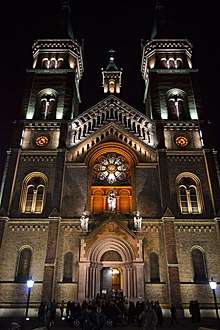
| District | Area (ha) | Romanian name | German name | Hungarian name | Institution |
|---|---|---|---|---|---|
| I | 480 | Cetate | Innere Stadt | Belváros | 1718 |
| II | 1017 | Fabric | Fabrikstadt | Gyárváros | 1718 |
| III | 668 | Elisabetin | Elisabethstadt | Erzsébetváros | 1890 |
| IV | 442 | Iosefin | Josefstadt | Józsefváros | 1744 |
| V | 205 | Mehala | Mehala | Mehala | 1910 |
| VI | 231 | Fratelia | Fratelia | Újkissoda | 1948 |
| VII | 156 | Freidorf | Freidorf | Szabadfalu | 1950 |
| VIII | 67 | Plopi | Kardos-Kolonie | Kardostelep | 1951 |
| IX | 72 | Ghiroda Nouă | Neu-Giroda | Erzsébetpuszta | 1951 |
| X | 102 | Ciarda Roșie | Rote Tscharda | Vörös Csárda | 1953 |
In the 21st century, Timișoara city is divided into quarters (cartiere):
- Listed alphabetically
- Aradului vest
- Badea Cârțan
- Banat I
- Blașcovici
- Braytim
- Bucovina
- Calea Aradului
- Calea Buziașului
- Calea Girocului
- Calea Lipovei
- Calea Lugojului
- Calea Șagului
- Calea Torontalului I, II
- Cetate
- Chișoda
- Ciarda Roșie
- Circumvalațiunii I, II, III, IV
- Complex studențesc
- Complex
- Crișan
- Dacia
- Dâmbovița
- Elisabetin
- Fabric
- Fratelia
- Freidorf
- Ghiroda Nouă
- Ion Ionescu de la Brad
- Iosefin
- Kuncz
- Lunei
- Matei Basarab
- Mehala I, II
- Mircea cel Bătrân
- Modern
- Noua Timișoară
- Olimpia
- Pădurea Verde
- Plăvăț
- Plopi
- Polonă
- Ronaț
- Soarelui
- Stadion
- Steaua
- Tipografilor
- Traian
- Zona Odobescu
Culture and contemporary life
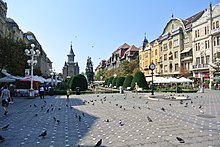
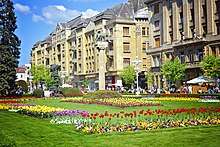
.jpg)
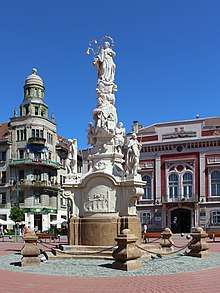
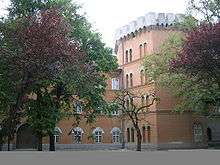
The city centre largely consists of buildings from the Austrian Empire era. The old city consists of several historic areas. These are: Cetate (Belváros in Hungarian, Innere Stadt in German), Iosefin (Józsefváros, Josephstadt), Elisabetin (Erzsébetváros, Elisabethstadt), Fabric (Gyárváros, Fabrikstadt). Numerous bars, clubs and restaurants have opened in the old Baroque square (Unirii Square).
Squares
- Victory Square (Piața Victoriei)
- Union Square (Piața Unirii)
- Liberty Square (Piața Libertății)
- Saint George Square (Piața Sfântul Gheorghe)
Religious buildings
Cultural buildings and sites
- Theresia Bastion
- Huniade Castle
- Bega Canal
- Capitoline Wolf Statue
- Banat Museum of Timișoara
Parks
- Timișoara Zoological Garden
- Botanical Park
- Central Park
- Cathedral Park
- Justice Park
- Roses Park
- Children's Park
- Queen Maria Park
- Alpineț Park
- Civic Park
- Green Forest
Performing arts
- Banatul Philharmonic
- National Opera of Timișoara
- National Theatre of Timișoara
- German State Theatre Timișoara
- Hungarian State Theatre Timișoara
- Merlin Puppet Theatre of Timișoara
Festivals and conferences
- Plai Festival
- Revolution Festival – music festival held at the Village Museum
- Timișoara Tango Festival
- Timișoara Jazz Festival – international jazz festival
- SABOTAGE Festival – electronic music and art festival
- Teszt Festival – international theatre festival
- Timishort – short movie festival
- Ceau, Cinema! – a "pocket-size" independent film festival
- StudentFest – a festival of culture and arts created by the students
- ISWin – The International Student Week in Timișoara
- Timișoara International Festival of Literature from Timișoara
- Street Delivery Festival – organized in Bucharest, Timișoara and Iași, the festival reaches areas such as architecture, music, theatre, dance and film
- TEDxTimișoara – an independent conference organised under license from TED Conference
European Capital of Culture
.jpg)
On 16 September 2016, Timișoara was selected as Romanian host city of European Capital of Culture in 2021.[61]
Shopping and commerce
Due to high demand for business space, new commercial buildings have been built. The commercial sector is developing very quickly. Timișoara has large shopping centres:
- Iulius Mall Timișoara
- Shopping City Timișoara
- Timișoara Centrum
Education

Timișoara is the main educational and academic centre in west of Romania. Timișoara has four public universities and four private universities. The number of students of higher education institutions reached 60,000 in 2015.
Public
- Politehnica University
- Universitatea de Vest
- Victor Babeș University of Medicine and Pharmacy
- Banat University of Agricultural Sciences and Veterinary Medicine
Private
- Universitatea Tibiscus
- Colegiul Tehnic de Vest
- Dimitrie Cantemir University
- Ioan Slavici University
Sport
Football
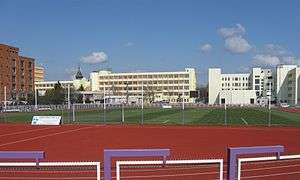
Handball
Basketball
Rugby union
International relations
Consulates










References
- Strutz, Rudolf. "Timișoara – City of Roses". issuu.com.
- "Results of the 2016 local elections". Central Electoral Bureau. Retrieved 3 April 2020.
- "Timiș County at the 2011 census" (PDF) (in Romanian). INSSE. 2 February 2012. Archived from the original (PDF) on 19 July 2012. Retrieved 16 February 2012.
- "Populaţia României pe localitati la 1 ianuarie 2016" (in Romanian). INSSE. 6 June 2016. Archived from the original on 27 October 2017. Retrieved 27 October 2017.
- "Error".
- "Timișoara". The American Heritage Dictionary of the English Language (5th ed.). Boston: Houghton Mifflin Harcourt. Retrieved 12 April 2019.
- "Timișoara" (US) and "Timișoara". Oxford Dictionaries UK Dictionary. Oxford University Press. Retrieved 12 April 2019.
- "Harta studenţilor din România: centrele universitare au atras cei mai mulţi investitori. Mai bine de 50% dintre studenţii români învaţă în doar trei oraşe din România | Ziarul Financiar". ZF.ro (in Romanian). Retrieved 15 October 2019.
- "Mii de străini veniți să facă Medicina în România pentru 5.000 de €/ an. Cât ar plăti în țările lor". Stirileprotv.ro. Retrieved 15 October 2019.
- "Preturi bune si lucrari de calitate. Motivele pentru care Romania a ajuns in top pe harta turismului dentar". Aktual24 (in Romanian). 22 July 2019. Retrieved 15 October 2019.
- "Turismul dentar, în creştere în România". Mediafax.ro (in Romanian). Retrieved 15 October 2019.
- Iasi, Ziarul de. "Iaşul este pe locul III în ţară după numărul de angajaţi din IT". www.ziaruldeiasi.ro. Retrieved 15 October 2019.
- Ceobanu, Bogdan Florin (10 December 2018). "Romania could be the next Berlin by 2020". Medium. Retrieved 15 October 2019.
- "Romanian city comes out first in the world in Internet download speed ranking". Net Index. 3 July 2013.
- "Art Nouveau European Route - Cities". coupdefouet.es. Retrieved 30 May 2020.
- Centru, Info. "Info Centrul Turistic Timișoara – Timișoara's Firsts". www.timisoara-info.ro.
- Romania’s Revolution, Then And Now
- https://ec.europa.eu/programmes/creative-europe/news/20160916%20-romania-european-capital-of-culture-2021_en
- Kiss, Lajos (1983). Földrajzi nevek etimológiai szótára [Etymological Dictionary of Placenames]. Akadémiai Kiadó. p. 637. ISBN 963-05-3346-4.
- Crețan, Remus (2007). "Banat toponymy – a short view on the origins of settlements in the eastern part of Timișoara". Review of Historical Geography and Toponomastics. II (3–4): 45–56. ISSN 1842-8479.
- "hírek / aktualitások". www.hajocsavar.hu. Retrieved 15 October 2019.
- "Vestigii ale dacilor ies la iveală. Localitate antică pomenită de Ptolemeu, descoperită în Banat". www.digi24.ro (in Romanian). Retrieved 15 October 2019.
- "Case datând din neolitic, descoperite lângă Timișoara". www.historia.ro. Retrieved 15 October 2019.
- "Timișoara | Romania". Encyclopedia Britannica. Retrieved 15 October 2019.
- Vistai András János (Adattári tallózásból összehozta). "Tekintő. Erdélyi helynévkönyv. III. kötet" (PDF). www.fatornyosfalunk.com (in Hungarian). Archived from the original (PDF) on 10 July 2011. Retrieved 5 November 2011.
- Szentkláray, Jenő (1911). Temes vármegye története – Temesvár története (in Hungarian). Budapest: Országos Monografia Társaság.
- Hațegan, Ioan; Boldea, Ligia; Țeicu, Dumitru (2006). Cronologia Banatului: Banatul între 934–1552 (PDF) (in Romanian). Timișoara: Editura Banatul. ISBN 973-7836-56-1. Archived from the original (PDF) on 3 September 2013. Retrieved 6 July 2018.
- Gate Azapa Citeste mai mult: adevarul.ro/locale/timisoara/aniversare-trista-timisoara-1552-s-a-lasat-intunericul-dominatiei-otomane-banat-1_50aef2737c42d5a663a1d771/index.html
- Connect, QCT. "History of Timișoara – Primaria Timișoara – City Presentation – Timișoara Municipality". primariatm.ro.
- "Archived copy". Archived from the original on 14 July 2014. Retrieved 28 June 2014.CS1 maint: archived copy as title (link)
- "Timișoara, monografie Istorică", dr.Nicolae Ilieșu
- "Agenda". Agenda.ro. Archived from the original on 13 May 2003. Retrieved 18 June 2010.
- "Agenda". Agenda.ro. Archived from the original on 26 December 2004. Retrieved 18 June 2010.
- Ilieșiu 2006, op. cit. p. 330
- "Timișoara, Romania – Travel and Tourism Information". romaniatourism.com.
- Industria Timişoarei (in Romanian)
- Fabricile celebre ale Timișoarei din comunism (in Romanian)
- Kotkin, Stephen (2010). Uncivil Society: 1989 and the Implosion of the Communist Establishment. Modern Library. pp. 84–87. ISBN 978-0-8129-6679-4.
- "20 decembrie 1989: Timișoara, primul oraş liber de comunism". www.digi24.ro. Retrieved 8 January 2016.
- "Timișoara, Romania Köppen Climate Classification (Weatherbase)". weatherbase.com.
- "Timișoara Climate Normals 1961–1990". National Oceanic and Atmospheric Administration. Retrieved 21 March 2015.
- "Klimatafel von Temeschburg (Temesvar, Timișoara), Banat / Rumänien" (PDF). Baseline climate means (1961–1990) from stations all over the world (in German). Deutscher Wetterdienst. Retrieved 23 November 2016.
- "Air Temperature (monthly and yearly absolute maximum and absolute minimum)" (PDF). Romanian Statistical Yearbook: Geography, Meteorology, and Environment. Romanian National Statistic Institute. 2007. Archived from the original (PDF) on 27 September 2007. Retrieved 21 March 2015.
- "Ethno-demographic Structure of Romania". The Ethnocultural Diversity Resource Center. Retrieved 15 April 2011.
- "Centrul de resurse pentru diversitate etnoculturală". Edrc.ro. 30 May 2010. Retrieved 18 June 2010.
- "Timișoara, mina de aur pentru investitorii italieni". 9am.ro. Retrieved 18 June 2010.
- QCT Connect (19 August 1992). ""Timișoara este floarea de la butonieră a relațiilor româno-italiene" | Primaria Timișoara | Secțiuni suplimentare | Cooperare internațională și dezvoltare economică". Primariatimisoara.ro. Retrieved 18 June 2010.
- Historical ethnicity of the Timiș County
- "Timisoara, the best city for business in Romania, in Forbes top 2016 – swisspointgroup". swisspointgroup.ro. Archived from the original on 18 October 2016. Retrieved 17 October 2016.
- "Continental Corporation -Istoric Continental". continental-corporation.com.
- "Grupul Continental vrea să recruteze 3.000 de noi ingineri în următorii doi ani – Ziarul Financiar". zf.ro.
- "Flextronics Romania to cut an additional 140". evertiq.com.
- "Velo TM – Timișoara Has The First Romanian Bike-Sharing System". Alexandru Garboni Blog.
- "Romania's Timișoara will provide free public transport by boat on the canal crossing the city". Romania-Insider. Archived from the original on 9 June 2016. Retrieved 6 June 2016.
- "Timișoara a devenit primul oraş din România cu transport public în comun pe apă". AGERPRESS. 4 October 2018. Retrieved 11 January 2019.
- "Timișoara – Gara (Timișoara, Timis, Romania) – Transport persoane cu autocare, autobuze sau microbuze la AUTOGARI.RO". autogari.ro.
- https://renasterea.ro/pe-un-cer-senin-si-cu-putin-noroc-aviatia-utilitara-timisoara-ar-putea-decola-saptamana-viitoare-spre-vremuri-mai-bune/
- "LEGE nr.215 din 23 aprilie 2001 Legea administraţiei publice locale". cdep.ro.
- "Noul Consiliu Local Timișoara". Opinia Timișoarei.
- "Avem rezultate finale oficiale! Vezi clasamentul partidelor și harta votului în Timiș, la Alegerile Locale 2016!". Opinia Timișoarei.
- "Timișoara to be the European Capital of Culture in Romania in 2021 – Creative Europe – European Commission". europa.eu.
- Connect, QCT. "Primaria Timișoara – Prezentarea oraşului – Oraşe înfrăţite". primariatm.ro.
- 友好城市 (Friendly cities) Archived 19 July 2014 at the Wayback Machine, 市外办 (Foreign Affairs Office), 22 March 2008. (Translation by Google Translate.)
- 国际友好城市一览表 (International Friendship Cities List) Archived 13 November 2013 at the Wayback Machine, 20 January 2011. (Translation by Google Translate.)
- 友好交流 (Friendly exchanges) Archived 12 November 2014 at the Wayback Machine, 13 September 2011. (Translation by Google Translate.)
- "Städtepartnerschaften" (in German). Stadt Karlsruhe. 16 December 2010. Archived from the original on 24 July 2010. Retrieved 5 January 2011.
- "European networks and city partnerships". Nottingham City Council. 22 June 2012. Archived from the original on 25 June 2012. Retrieved 6 September 2019.
- "Archived copy". Archived from the original on 18 May 2015. Retrieved 7 May 2015.CS1 maint: archived copy as title (link)
- "Ministry of Foreign Affairs: Consulate General of Federal Republic of Germany in Timișoara". mae.ro.
- "Ministry of Foreign Affairs: Consulate General of Serbia in Timișoara". mae.ro. Archived from the original on 4 April 2015. Retrieved 18 June 2018.

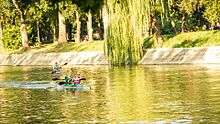


.jpg)
